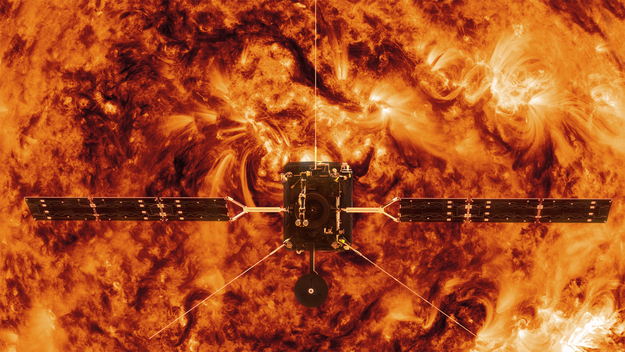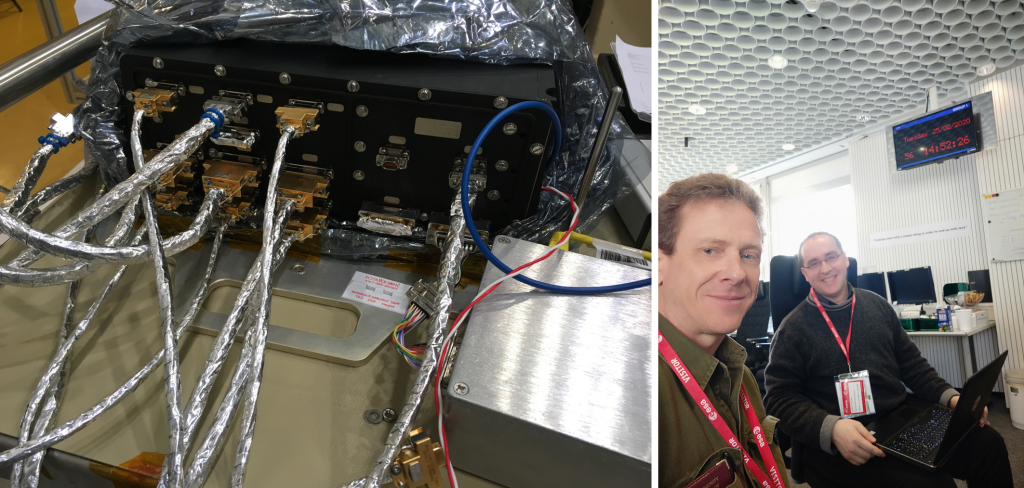The EUI telescope is waking up
The Solar Orbiter spacecraft was launched on February 10, 2020 from Cape Canaveral, carrying onboard the space telescope Extreme Ultraviolet Imager (EUI). On February 25, EUI got the wake up call. At this stage we can happily report that EUI is awake: its temperature is ok, its computer has been successfully powered on and completed the self-tests and EUI could move its filter wheel mechanisms. All good!
Launching a space telescope and operating it for the first time in space is a delicate business. During the launch, the satellite and its instruments undergo a tremendous amount of vibrations. Once in space, the temperatures of the instruments can change drastically depending on the orientation of the spacecraft. Water and atmospheric particles can condense and stay glued on the sensitive areas of the instruments, creating a ‘misty window’ effect. Also, instrument electronics can be affected by extreme temperatures or space radiation. All these potential showstoppers are examined, checked and sorted out during the ‘Near-Earth Commissioning Phase’ that runs from shortly after launch till June 25. This is the day of the ‘Commissioning Review’: all the collected evidence is evaluated and, if positive, Solar Orbiter is declared ready for operations.
We run through a series of steps to slowly awaken EUI and finally, to get it fully up and running.
On February 25, the wake up process was initiated. A big first hurdle was taken when the “Common Electronics Box” (CEB) – this is the instrument computer – was switched on. The CEB reported to Earth that EUI was in a safe situation. This was a big relief as a failed switch-on of the CEB computer was the number 1 catastrophic risk for the EUI project and would have resulted in a dead instrument. Secondly, the computer reported that its self-tests were completed successfully, re-assuring the team that the electronics, memory and software were undamaged and ready for their duties. Thirdly, EUI confirmed that it can turn its camera filter mechanisms. In a later stage, we will ask EUI to check the camera electronics by taking an image, even if the telescope doors are still closed. Later, once the spacecraft has outgassed sufficiently and the mist has disappeared, we will ask EUI to open the telescope doors and start taking up their scientific work. The first EUI images will be released in July, together with the first images and data of the other Solar Orbiter instruments.
Below a short representation of the communication during the ‘wake up call’ of EUI from the European Space Operations Centre, ESOC, in Darmstadt. Two EUI team members followed the awakening of EUI at ESOC and were available to intervene when necessary.
The other EUI team members followed from their home institutes: the Institut d’Astrophysique Spatiale (France), Max-Planck-Institut für Sonnensystemforschung (Germany), UCL-Mullard Space Science Laboratory (United Kingdom), Physikalisch-Meteorologisches Observatorium Davos/World Radiation Center (Switzerland), Centre Spatiale de Liège and the Royal Observatory of Belgium (Belgium). ROB is responsible for the scientific exploitation of EUI.
Feb 25, 16:04 CET
Philip Smith, from Darmstadt, Germany: ’Making the spacecraft Solar Orbiter ready for start up of EUI.’
Feb 25, 18:10 CET
Koen Stegen, from Darmstadt, Germany: ‘All four parts could be correctly powered on! Running self tests now. The spacecraft is 24 light-seconds away.’
Feb 25, 20:09 CET
Koen Stegen, from Darmstadt, Germany: ‘Self-tests ran fine.’
Feb 25, 21:07 CET
Koen Stegen, from Darmstadt, Germany: ‘Too soon yet to say hurray. One filter wheel moves as expected. The other filter wheel has a schönheitsfehler. This can be fixed.’
Feb 25, 20:14 CET
David Berghmans, from ROB, Belgium: ‘The temperature of both filter wheel motors seems to be high. The heartbeat of EUI dropped.’
Feb 25, 21:17 CET
Koen Stegen, from Darmstadt, Germany: ‘We will take action. Missing heartbeats during booting of the EUI computer are normal. We will continue monitoring the heartbeat of EUI.’
Feb 25, 21:58 CET
Koen Stegen, from Darmstadt, Germany: ‘We’ve turned on the heaters. But they seem to heat too much.’
Feb 26, 00:32 CET
Koen Stegen, from Darmstadt, Germany: ‘We have turned on the heaters at 50% power, it will keep the temp below the critical point. I’m going home soon.’
Feb 26, 07:31 CET
David Berghmans, from ROB, Belgium: ‘Things are looking great this morning!’
Congratulations came in from Belgium, France, Germany, Switzerland, United Kingdom.
More information:


